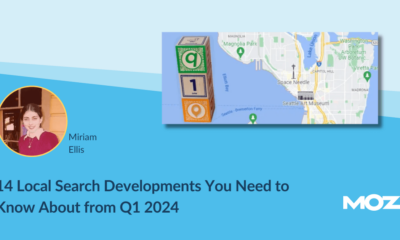MARKETING
Local Economics Through the Lens of Elected Officials and Organizers

The author’s views are entirely his or her own (excluding the unlikely event of hypnosis) and may not always reflect the views of Moz.
If you want to serve local business owners, allying your company with their deepest needs matters. Recently, the Institute for Local Self-Reliance provided a valuable opportunity to hear directly from localism advocates and elected officials about small business owners’ goals and obstacles. If your brand is marketing software or other services to this largest sector of American commerce, I highly recommend setting aside an hour this week to watch the whole recording (embedded at the end of this post).
Today, I’ll briefly recap the information from this event that stood out to me as most illuminating, in hopes that you will be able to evaluate these messages to help you find common cause with clients and customers.
The present state of local economics in the U.S.
ILSR’s co-director, Stacy Mitchell, began the webinar by remarking that, just a decade ago, it was not common to hear much political talk surrounding small businesses versus monopolies, but that this is changing. Advocacy groups are gaining strength and political factions like the 100-member progressive caucus are increasingly getting out the message about the present state of U.S. local economics, which Mitchell summed up this way:
“Today, we know that economic concentration and the losses that we’ve seen both for working people and for small businesses have had devastating effects on communities; that the decline of small businesses and the growing concentration across our communities is really driving racial and economic inequality, ultimately undermining our democracy. And we know that the primary driver of this is corporate power, whether it’s the power these corporations wield in the market or the political power they have to rig government policy in their own favor and to undermine their smaller competitors.”
What local business owners want
Chanda Causer, the Co-Executive Director of The Main Street Alliance, gave this list of priorities she hears voiced by the SMB owners she speaks with every day:
The question was raised as to what business owners and organizers can do to get the public to care about these requirements, and about local economic health. Visiting Fellow at the Harvard Kennedy School’s Shorenstein Center on Media, Politics and Public Policy, Brandi Collins-Dexter explained,
“I think that everybody I talk to cares about this; big business has such a ubiquitous role in our lives that I think people just don’t know what to do about it.”
This quote will resonate with every local search marketer who has been reading survey stats for the past two years that claim three-quarters or more of the public is committed to shopping more locally, and yet, sees how all of our choices have been whittled down to a frustrating dependence on Amazon, Walmart, Target, or dollar store-type options.
I believe that the majority of Americans genuinely do want to shop small and care sincerely about the communities in which they live, but when we need to buy a blender or a book, we increasingly face the stark reality that our town’s independent hardware store or bookshop was driven out of business by economic policy. Meanwhile, our intelligence is repeatedly insulted by monopolies portraying themselves as local heroes and using offensive scare tactics to warn SMBs and the public against any legislation that would limit their profits.
Solutions, obstacles, and hope
If industry surveys and local advocacy groups indicate that the public already cares about the survival of local business owners, we’re already part of the way to solving the dilemma of the economic role of small businesses being cut by 50% over the past 40 years.
What emerged from the ILSR event was a three-part approach to realizing the society that surveys say we want. If implemented, it would take local business owners on a journey from a place of fear to a place of respect and protection.
Education
First, Ms. Causer emphasized the need for continuing dialogue and education, encouraging individuals to take the time to speak about their concerns with their own neighbors, concerns like the effects of monopoly on the community. An educated public is one that can bring pressure to bear on representatives.
Pro-local legislation
Secondly, Congresswoman Pramila Jayapal, who represents the Seattle area and part of King County, is focused on a legislative approach. She is the vice-chair of the subcommittee on antitrust, which conducted a 16-month investigation into the operations of tech monopolies. She introduced HR 3825, designed to prevent corporations like Amazon from demoting merchants on their platforms while simultaneously preferencing their own cheaper product lines – a practice that has been devastating to small entrepreneurs. She is also attempting to directly address the dire needs of all business owners (and the general public) for healthcare amid the pandemic with her HR 1976 Medicare for All bill. As she stated, “The way that local communities do well is to have a thriving small business economy.”
However, Assemblymember Ron Kim, whose district has the largest proportion of small business owners in New York State, was frank about the obstacles standing in the way of the needs of local business owners and communities being met:
“As long as we’re spending, in a place like New York, $7-8 billion a year in tax breaks to subsidize the growth of mega-monopolies and big companies who, in return, donate millions and millions of dollars to executive officers and governors and mayors to keep this game going, we’re going to have a continuous problem.”
Make bribes illegal
This means that the third, and most essential, element in the three-part dynamic is to make it illegal to bribe political candidates and elected officials. Without this stipulation, even the most caring and educated public will find its needs ignored, and pro-local legislation will continue to be defeated by corrupt officials who have been paid by corporations to create policy that serves them.
The scenario may seem hopeless, but it isn’t, because you — who work in tech amid the long-shadowed boulders of monopoly — are reading this article and have a voice. Your co-workers have voices, too, and can advocate for your brands developing authentic allyship with clients and customers.
Our industry has published volumes on the necessity of building relationships with the communities we want to serve. It’s a worthy aspiration, which hinges on listening well and demonstrating solidarity. Honest chats with independent business owners produce stories like Assemblymember Kim’s, about how one of the oldest Korean-American restaurants in his community is becoming a worker co-op to be able to continue operating in a broken economy.
You’ll hear family stories like those of Ms. Collins-Dexter, whose great-grandfather was forced off his land by a powerful tobacco trust, and had to start over again as an auto mechanic whose shop became a major source of community aid during the Great Depression.
You’ll hear neighbors like Ms. Causer explain that 68% of respondents surveyed by her organization want to talk about monopoly, and that she’s advocating for people tp start singing the union songs again — that our grandmothers sang.
And you’ll hear the local business owners whom Congresswoman Jayapal said would only give comments to her antitrust committee in private, because they so fear punishment by the monopolies.
The takeaway
The next time you’re asked how to build out the stages of your customer’s journey, consider asking your team and bosses to begin by donning the shoes of a local business owner. They’re the people in your community who are living in real fear of being put out of business by national, state, and local policy, and of being made invisible by powerful platforms in daring to speak out. Empathy for this plight could be the start of the most genuine relationships your company has ever developed. It could even be the basis of a coalition of industry agencies and SaaS groups bringing their own, collective pressure to bear on public servants, to insist that we finally do get money out of politics and re-balance our economics to prioritize societal well-being.
As a local SEO, I’ve often looked at Google’s local guides program. There are roughly 150 million of these community interpreters globally, and they write an average of 62% of the reviews you read. That’s a lot of people with a lot of potential power, if they ever chose to organize on behalf of the local businesses they so abundantly grade. Why would they do that? Because there is little left to review when a local business landscape is reduced to just one or two monopolies. There is no fun or joy in that.
I think Brandi Collins-Dexter is right about good people not knowing what to do, and I suspect a lot of that feeling of powerlessness is rooted in a sense of isolation. But, just like there are a lot of local guides, there are a lot of tech workers, and together, we can help build the hope we seek from emboldened collaboration.
Watch the recording
MARKETING
How Tagging Strategies Transform Marketing Campaigns


As a marketer, I understand how today’s marketing campaigns face fierce competition. With so much content and ads competing for eyeballs, creating campaigns that stand out is no easy task.
That’s where strategies like tagging come in.
It helps you categorize and optimize your marketing efforts. It also helps your campaigns cut through the noise and reach the right audience.
To help you out, I’ve compiled nine ways brands use a tagging strategy to create an impactful marketing campaign.
Let’s get to it.
How Brands Use a Tagging Strategy
Tagging involves using keywords or labels to categorize and organize content, products, or customer data. You attach tags to specific items or information to make searching, sorting, and analyzing data easier.
There are various types of tags, including meta tags, analytics tags, image tags, hashtags, blog tags, and more.
So, how do brands use a tagging strategy to make their marketing campaigns stand out?
Improve Social Media Engagement
With over 5 billion users, social media provides an easy way to connect with your audience, build relationships, and promote your offerings.


Use a tagging strategy to boost social media interactions. Consistently use hashtags that align with current trends and topics. This encourages people to interact with your content and boosts content visibility.
You can also use tags to monitor brand mentions of your products or your industry. This allows you to engage with your audience promptly.
Consider virtual social media assistants to streamline your tagging strategy. These AI-driven tools can suggest relevant hashtags, track mentions, and automate responses. Implementing them can save time and resources while ensuring consistent engagement across your socials.
Build a Personal Brand on LinkedIn
LinkedIn is the world’s largest professional networking platform, with over 1 billion members across 200 nations. It offers excellent opportunities for individuals and businesses to build and nurture their brands.


However, simply creating a professional profile isn’t enough to build a personal brand on LinkedIn.
Use various tags to increase your visibility, establish thought leadership, showcase expertise, and attract the right connections. For instance, use skill tags to showcase your expertise and industry tags to attract connections and opportunities within your industry. Use certification tags to help showcase your expertise and credibility to potential employers or clients.
Facilitate Customer Segmentation and Personalization
Personalization matters—more so in today’s data-driven world. In fact, 65% of consumers expect your brand to adapt to their changing preferences and needs.
To meet this expectation, consider using a tagging strategy.
Segment your customers based on shared characteristics, such as demographics, interests, purchase history, cart abandonment, and behavior.
Here’s a summary of the steps to customer segmentation.


With your customer segments ready, use tags to tailor your marketing messages and offerings to specific segments. Imagine sending targeted email campaigns based on what your customers need. That’s the power of segmentation and tagging in action!
Enhance SEO and Content Discoverability
Tagging content can have a profound impact on search engine optimization (SEO) and content discoverability. When users search for specific topics or products, well-tagged content is more likely to appear in search results, driving organic traffic to your website.
Additionally, tags can help you analyze the most popular topics with your readers. Then, the results of this analysis can help you adjust your content strategies accordingly.
And get this— certain AI tools can help analyze your content and suggest relevant tags and keywords. Using these tools in addition to a tagging strategy can help optimize your SEO strategies and boost content discoverability.
Partner with the Right Influencers
Influencer marketing has become a go-to marketing approach for modern brands. Recent stats show that 85% of marketers and business owners believe influencer marketing is an effective marketing strategy.
But how do you find the perfect influencer for your campaign?
Utilize tags to identify influencers who are relevant to your niche. Beyond this, find influencers who align with your brand values and target audience.
Additionally, look for influencers who use hashtags that are relevant to your campaigns. For instance, fashion influencer Chiara Ferragni uses #adv (advertising) and #ghd (good hair day) hashtags in this campaign.


Monitor industry-specific hashtags and mentions to discover influential voices and build profitable relationships with them.
Track Hashtag Performance
Tracking your hashtag performance helps you understand your campaigns’ engagement, reach, and effectiveness.
To achieve this goal, assign special hashtags to each marketing project. This helps you see which hashtags generate the most engagement and reach, enabling you to refine your tagging strategy.
Here’s an example of a hashtag performance report for the #SuperBowl2024.


This curated list of hashtag generators by Attrock discusses the top tools for your consideration. You can analyze each and choose the one that best fits your needs.
Categorize Content Accordingly
The human attention span is shrinking. The last thing you want is for your audience to have difficulty in finding or navigating your content, get frustrated, and bounce.


Untagged content can be difficult to navigate and manage. As any marketer knows, content is important in digital marketing campaigns.
To categorize your content, identify the main categories by topics, themes, campaigns, target audiences, or product lines. Then, assign relevant tags based on the categories you’ve identified. After that, implement a consistent tagging strategy for existing and new content.
Organizing your content using tags can also help streamline your content management workflow. Most importantly, readers can easily find the content they’re looking for, thereby boosting overall user experience, engagement, and conversions.
Boost Your Email Marketing Strategy
Email marketing remains a powerful marketing tool in today’s digital world. It’s also another area where brands use a tagging strategy to directly reach their target audience.
Use tags to segment your email list and personalize your marketing messages. Then, you can send targeted emails based on factors like purchase history, interests, and demographics.
Personalization can significantly improve open rates, CTRs, and overall engagement and conversion rates. It’s a simple yet impactful strategy to make your email marketing strategy more effective.
Plus, you can use tags to track how well your emails perform with each group. This helps you understand what content resonates best with your audience and provides insight on how to improve your emails going forward.
Enhance Analytics and Reporting
Every marketer appreciates the immense value of data. For brands using tagging strategies, tags are powerful tools for gathering valuable data.
Analyze how users interact with your tagged content. See which tags generate the most clicks, shares, conversions, and other forms of engagement. Gain insight into audience preferences and campaign effectiveness.
This granular data about your marketing efforts allow you to make data-driven decisions, allocate resources effectively, and refine your marketing strategies.
Final Thoughts
There isn’t a single correct way for brands to use a tagging strategy in marketing. You can use a tagging strategy however you see fit. However, the bottom line is that this strategy offers you a simple yet powerful way to create attention-grabbing and unique marketing campaigns.
Fortunately, tagging strategies are useful across various marketing initiatives, from social media and email marketing to SEO and more.
So, if you’re ready to elevate your marketing campaign, build a strong brand presence, and stand out among the competition, consider employing effective tagging strategies today.
MARKETING
Tinuiti Recognized in Forrester Report for Media Management Excellence

Tinuiti, the largest independent full-funnel performance marketing agency, has been included in a recent Forrester Research report titled, “The Media Management Services Landscape, Q2 2024.” In an overview of 37 notable providers, this comprehensive report focuses on the value B2C marketing leaders can expect from a media management service provider, and analyzes key factors to consider when looking for a media management partner such as size and business scenarios. B2C marketing executives rely on media management services to:
- Augment the efficacy of media investments
- Bridge media impressions to commerce transactions
- Enhance ad campaigns to drive performance
Report authors, VP, Principal Analyst Jay Pattisall and Senior Analyst Nikhil Lai call attention to the pressing need for providers to prove their value, deliver profitable ROAS, and drive alignment between CMOs and CFOs and thus liberate strained marketing budgets.
Our Always-On Incrementality tool – which is a part of our patented tech, Bliss Point by Tinuiti – empowers marketers to validate the incrementality of their spend on each ad set, media channel, and marketing tactic so marketers can create stronger, more focused campaigns that get the job done without sacrificing the bottomline.
B2C marketing leaders often seek and expect key business scenarios from media management service providers including media measurement and attribution, data strategy, and marketing mix modeling. MMM’s adaptability to the post-cookie/ post-IDFA world positions it as an essential tool for marketers. As businesses seek to connect the dots, leverage data, and make strategic decisions, MMM is a crucial ally in the dynamic realm of mixed media advertising. Our Rapid Media Mix Modeling sets a new standard in the market with its exceptional speed, precision, and transparency.
According to the Forrester report, “46% of senior B2C marketing and advertising decision-makers say they plan to integrate performance and brand media assignments with a single media agency in the next 12 months…”
In our quest to better understand all revenue-driving aspects of a given campaign, we have started on a process to quantify the impact of Brand Equity, which we believe is one of the largest missing pieces in more accurate and complete measurement.
Learn more about Bliss Point by Tinuiti, our use cases, and our approach to performance and brand equity.
The Landscape report is available online to Forrester customers or for purchase here.
MARKETING
Let’s Start Treating Content More Like We Treat Code

The technology space is pretty obsessed with preventing code defects from getting to production. We take great pains to make sure that a mistake doesn’t make it from the developer’s fingertips all the way through to the product system.
There’s an entire field called DevOps (short for “development operations”). This is something like a $5 billion industry. There are entire market segments filled with companies that tightly control the movement and testing of code.
Search for “DevOps diagram” sometime. You’ll be amazed at what you find—detailed schematics showing exactly how code should be copied, packaged, tested, and deployed. Developers who don’t have an artistic bone in their bodies suddenly turn into Da Vinci when describing in exacting detail how they want to orchestrate code deployments.
All of this is in search of one goal: prevent bad code from reaching production. A lofty goal, to be sure.
…but why don’t we care so much about content?
Where we have majestic acrobatics on the code side, when it comes to content, the process is usually something like, “Well, Alice writes something in Word, then emails it to Bob, and he copies it into the rich text editor” then presses publish.
Congratulations, you have the tightest, most reliable codebase serving up terrible content. A+. Great job.
Content defects are a thing, and we don’t do enough to prevent them. In particular, we don’t look at content development as a process to be managed. We think it’s some kind of magic, not a flow of work with checkpoints, trackable assignments, and review gateways. We’re somehow convinced this would take the “soul” out of it or something.
So, while our developers get six figures worth of toys to make sure they can swap every line of code instantly without spilling their coffee, our content creators are copying and pasting things into Slack and yelling “I swear sent that to you last week!” over the cubicle wall.
We need to do better.
Content creation isn’t magic—no more than code is magic. It’s a process that can and should be managed just like code deployments, and it deserves the same level of regard.
Your content creators need:
- Library services. Your developers have source code management. They know where code is, all the time. They probably have versions of it dating back to when they were teenagers. These things exist for content as well—they’re called content marketing platforms (CMPs) and digital asset management systems (DAMs). They’re designed to store, organize, and version content assets so creators know where everything is.
- Change management, in the form of editorial calendaring. Your developers know when code will be released (note: don’t do it on Fridays). They plan these things long in advance. But ask a content creator when Content Item X for the new campaign is launching, and they can only say something like, “I don’t know. I showed it to Bob. It’s in his court now…”
- Workflow. Developers have detailed ticket management systems that can tie their actions down to the exact line of source code they changed to resolve a defect. These systems exist so that everyone knows, at all times, who is responsible for what. Meanwhile, the content editors can only shrug when someone asks who was supposed to edit the CEO’s blog post that she just announced from the keynote stage.
- Content preview. I promise you that your development team has a graduated system of environments where they test code. They probably spend hundreds of hours maintaining it, so they can run code in isolation and know exactly how it works before they deploy it. Think of that fondly next time when your image caption is published in 30pt bold-faced font because no one told you that it wouldn’t be. (Incidentally, I’ve been thinking about preview a lot lately.)
Here’s why this is important:
Content defects matter. They can be far more damaging than code defects, while being so much harder to detect. By the time you realize something is wrong, the problem may have been existing in public for a long time, doing a lot of damage.
Imagine that you have a software company, and you’ve been trying to get an analyst to include your software in one of their reports. Your Analyst Relations staff has been consistently courting, cajoling, and hinting to this analyst that your software fits their segment exactly, and would be a great addition to the report.
The analyst finally decides to check things out. They go to your website, looking for evidence of all the things you told them about. They expected to find reinforcement of that information, that energy, that…vibe.
But, they didn’t. Their experience fell flat. They gave you a 20-minute chance, but then clicked away and didn’t look back.
Oh sure, you had plans. You were going to revamp that part of the website, and you had mentioned it to Gary just before he went on vacation. You heard some rumors that people were working on it, and some content got changed, but you never saw and never had a chance to guide it. Content development seemingly happened in a far-off land somewhere. Normally, when something changed on the website, you were as surprised as anyone.
This is a content defect. The whole thing. One big defect.
Why don’t we categorize like this? Why don’t we call it what it is?
Maybe because it’s not…binary? With code, things often either work, or explode spectacularly, so we can stand back and confidently say, “Yup, that’s busted.”
But with content, there’s a spectrum—there’s a range. People can look at it and say, “yeah, that’s fine” even when it’s not.
The only solution here is process. You need a way to make sure that content is seen by the right people, and at the right time, and has a way of reflecting the right input.
This happens with code all the time. We handle code exactingly, rigorously, and with due process and care.
We need to demand the same for content. And we need to start acknowledging that poor content is a failure of process, a failure of planning, and a failure of tooling.
The tools are available to avoid this. We need to implement them and use them.
Interested in learning how Optimizely Content Marketing Platform can better support your content creation process? See how it works in this quick video.
-
SEARCHENGINES6 days ago
Daily Search Forum Recap: April 29, 2024
-

 SEARCHENGINES7 days ago
SEARCHENGINES7 days agoOffline For Last Days Of Passover 5784
-

 MARKETING6 days ago
MARKETING6 days agoQuiet Quitting vs. Setting Healthy Boundaries: Where’s The Line?
-
SEARCHENGINES5 days ago
Daily Search Forum Recap: April 30, 2024
-

 MARKETING4 days ago
MARKETING4 days agoHow To Develop a Great Creative Brief and Get On-Target Content
-

 PPC6 days ago
PPC6 days agoHow to Promote Your Digital Marketing Agency: 4 Growth Strategies
-

 SEO4 days ago
SEO4 days agoWhy Big Companies Make Bad Content
-

 WORDPRESS7 days ago
WORDPRESS7 days agoBest WordPress Themes of All Time: Improve your Website SEO

















You must be logged in to post a comment Login